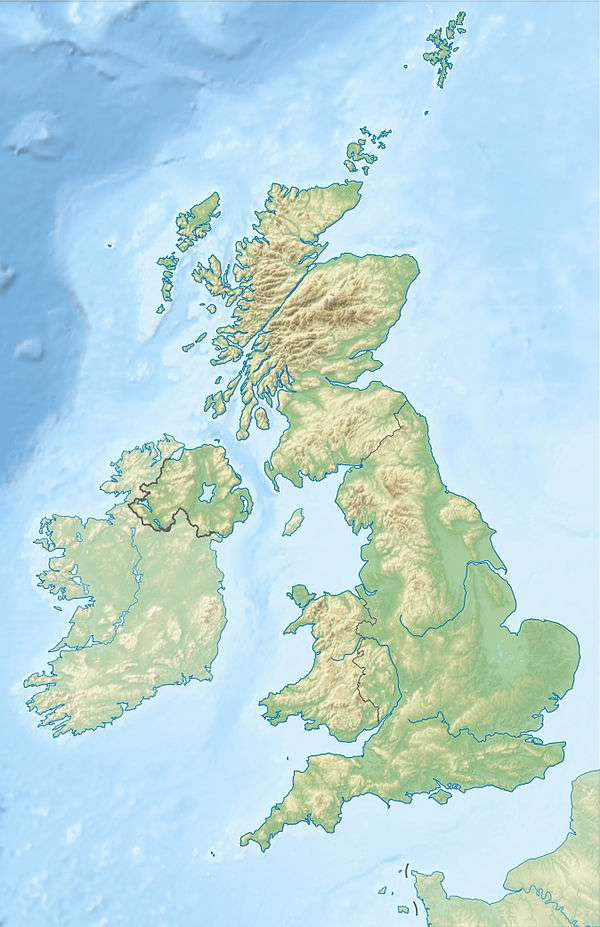Bromsgrove Sandstone
The Bromsgrove Sandstone is a geologic formation of the Sherwood Sandstone Group in England. It preserves fossils and ichnofossils of Chirotherium barthii, and Chirotherium sickleri, dating back to the Middle Triassic (Anisian) period.[1]
| Bromsgrove Sandstone Stratigraphic range: Anisian ~247.2–242 Ma | |
|---|---|
| Type | Formation |
| Unit of | Sherwood Sandstone Group |
| Lithology | |
| Primary | Sandstone |
| Other | Shale, conglomerate, marl |
| Location | |
| Coordinates | 52.7°N 2.3°W |
| Approximate paleocoordinates | 15.6°N 10.8°E |
| Region | |
| Country | |
 Bromsgrove Sandstone (the United Kingdom)  Bromsgrove Sandstone (England) | |
Fossil content
- Bromsgroveia walkeri
- Bromsgroviscorpio willsi
- Ceratodus laevissimus
- Cyclotosaurus leptognathus, C. pachygnathus
- Langeronyx brodiei
- Mesophonus perornatus, M. pulcherrimus
- Palaeosaurus cylindrodon
- Rhombopholis scutulata
- Spongiophonus pustulosus
- Stenoscorpio gracilis, S. pseudogracilis
- Willsiscorpio bromsgroviensis
- Acrodus sp.
- Dipteronotus sp.
- ?Gyrolepis sp.
- Mastodonsaurus sp.
- Archosauria indet.
- Dinosauriformes indet.
- Nothosauria indet.
- Rhynchosauridae indet.
gollark: Good for them?
gollark: It's the holidays now and I don't actually have the hardware, so I'm going to research OpenCV stuff, come up with a nice way to remote-control it, and look into better motors.
gollark: Currently all it can do usefully is move slightly, the ultrasonic sensor/accelerometer thing aren't hooked up to this Pi.
gollark: One of them seems to be mismatched, so it veers horribly left.
gollark: The ultrasonic one is easy, the accelerometer/gyro was mildly annoying due to poor docs but is doing things now, getting useful stuff from the camera means complex computer vision things.
References
- Bromsgrove Sandstone at Fossilworks.org
Further reading
- M. J. Benton and A. D. Walker. 1996. Rhombopholis, a prolacertiform reptile from the Middle Triassic of England. Palaeontology 39(3):763-782
- M. J. King, W. A. S. Sarjeant, D. B. Thompson and G. Tresise. 2005. A Revised Systematic Ichnotaxonomy and Review of the Vertebrate Footprint Ichnofamily Chirotheriidae from the British Triassic. Ichnos 12(4):241-299
- E. N. Kjellesvig-Waering. 1986. A restudy of the fossil Scorpionida of the world. Palaeontographica Americana 55:1-287
- R. I. Murchison and H. E. Strickland. 1837. On the upper formations of the New Red System in Gloucestershire, Worcestershire, and Warwickshire; showing that the Red or Saliferous, including a peculiar band of sandstone, represent the "Keuper" or "Marnes irisées;" with some account of the underlying sandstone of Ombersley, Bromsgrove, and Warwick, priving that it is the "Bunter Sandstein" or "Grès bigarré" of foreign geologists. Transactions of the Geological Society of London, series 2 5(26):331-348
- L. J. Wills. 1910. On the fossiliferous lower Keuper rocks of Worcestershire, with descriptions of some of the plants and animals discovered therein. Proceedings of the Geologists' Association 21:249-331
This article is issued from Wikipedia. The text is licensed under Creative Commons - Attribution - Sharealike. Additional terms may apply for the media files.